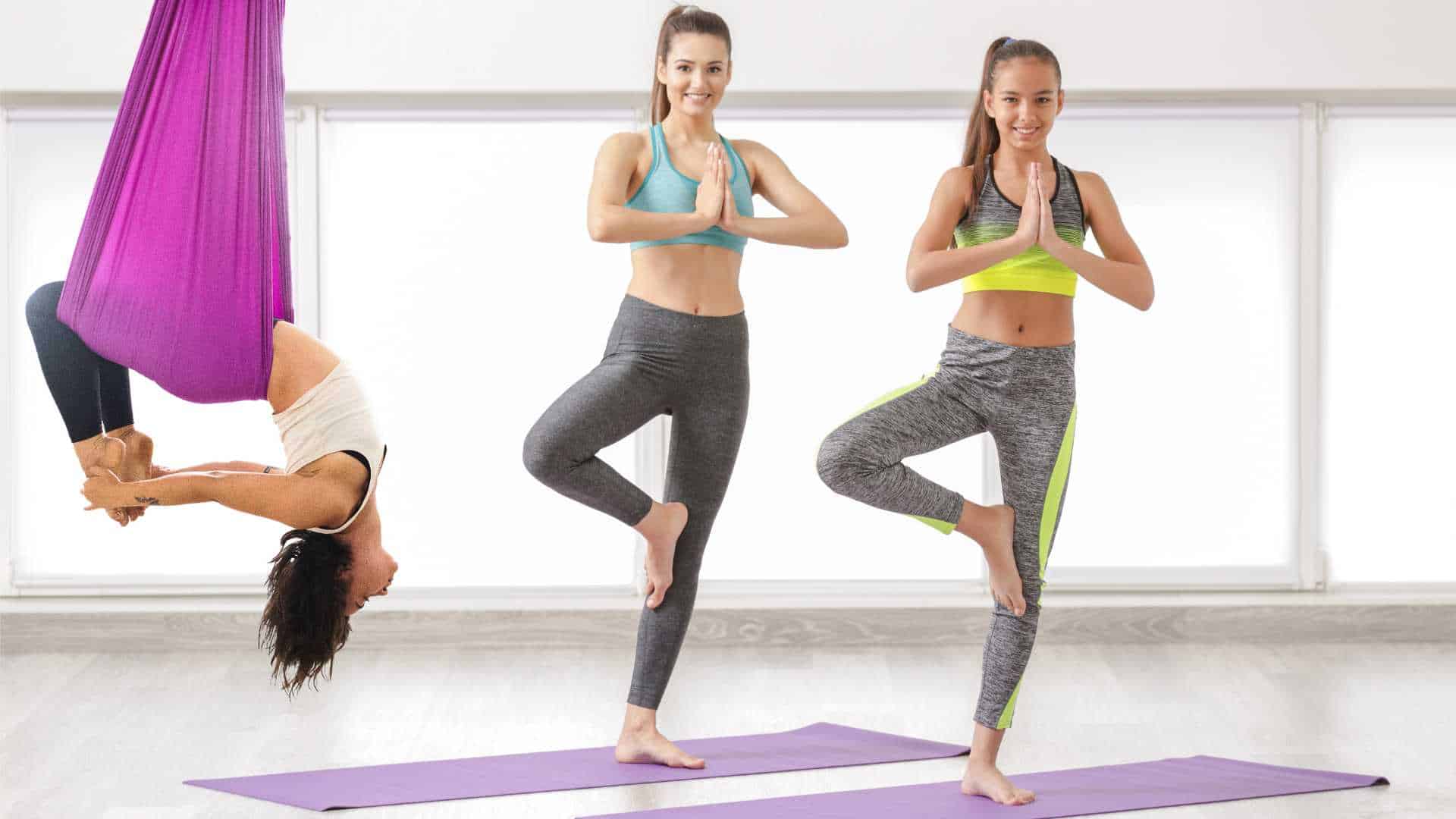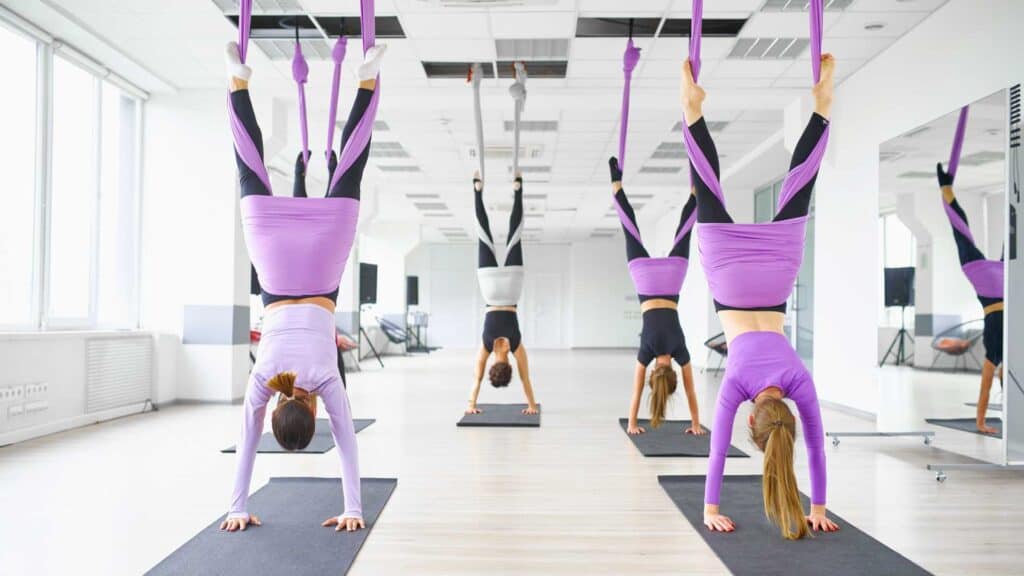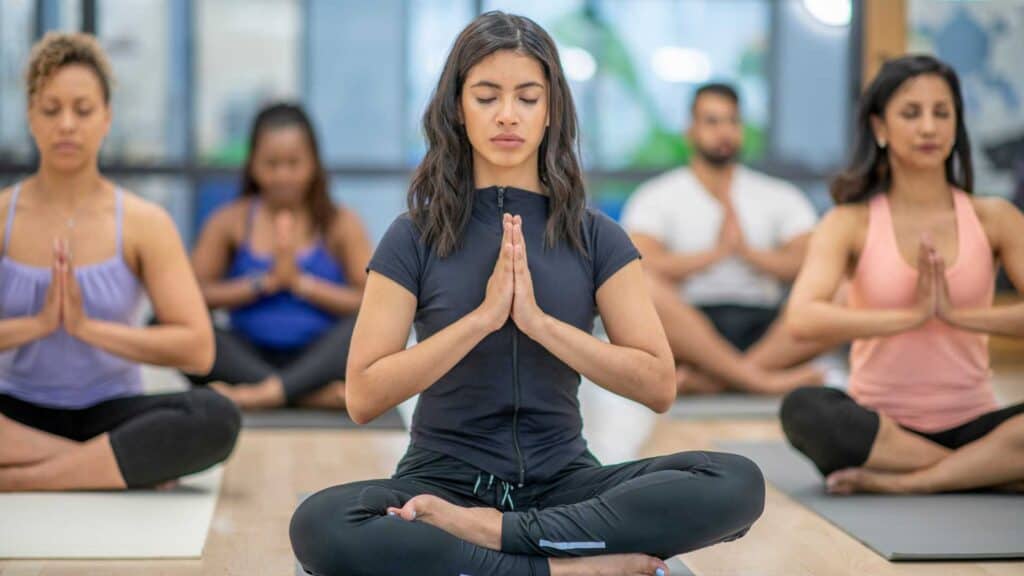Aerial yoga, a modern twist on the ancient practice of traditional yoga, merges the foundational principles of yoga with the dynamics of aerial arts.
Utilizing a hammock or silk suspended from the ceiling, aerial yoga allows you to perform various poses that may be challenging on the ground, thus adding an entirely new dimension to the practice.
This form of yoga aims to improve flexibility, strength, and balance, enjoying the added benefit of spine decompression through the hammock’s support.
On the other hand, traditional yoga is practiced on a mat and has been doing so for thousands of years. It focuses on strength, balance, and flexibility through various postures and breathing exercises.
Traditional yoga is known for its ability to promote mental and physical wellness, mindfulness, and relaxation.

Comparing aerial yoga to its traditional counterpart involves examining its accessibility, the physical benefits each provides, and the unique experience both bring to the practitioner.
Key Takeaways
- Aerial yoga combines traditional poses with aerial arts using a hammock for support, which can enhance physical benefits.
- Traditional yoga, performed on a mat, emphasizes mental and physical wellness through postures and breath control.
- Comparing the two yoga practices reveals distinct differences in experience, accessibility, and specific health benefits.
Understanding Aerial Yoga

In fitness and meditation, aerial yoga is a unique blend of traditional yoga fused with the graceful movements of aerial arts.
Origins of Aerial Yoga
Aerial yoga is a relatively new type of yoga that originated out of New York in 2007. It was developed by innovators exploring the combination of yoga postures with the dynamic nature of aerial arts. This fresh take on ancient practices sought to make traditional yoga’s physical and mental benefits more accessible and engaging, especially for those seeking an invigorating addition to their exercise routine.
The Aerial Yoga Hammock
Central to aerial yoga is the silk hammock, an apparatus that acts as a swing or soft trapeze, enabling you to perform various yoga poses in the air. The hammock supports your body’s weight, helps to deepen stretches, and reduces the strain on your joints, allowing for a full range of motion. The hammock’s versatility allows beginner and advanced postures, from simple stretches to more intricate, inverted poses.
Basics of Traditional Yoga

In traditional yoga, you’ll discover a practice rooted in ancient philosophy that emphasizes physical postures, breath control, and meditation.
Foundations of Yoga Practice
Your yoga practice is anchored in the Yamas and Niyamas, ethical guidelines that shape your approach to life and the self. Here, the focus is on Asana (physical postures), Pranayama (breath control), and Dhyana (meditation). These foundational elements enhance your physical, mental, and spiritual well-being.
Traditional Yoga Poses
When you engage in traditional yoga poses, you explore a variety of postures that range from standing and sitting to balancing and more. Each pose, known as an Asana, has specific physical benefits. For instance:
- Like Tadasana (Mountain Pose), standing poses build strength and stamina.
- Sitting poses, such as Paschimottanasana (Seated Forward Bend), increase flexibility and calm the nervous system.
These traditional postures improve your physical fitness and prepare your body and mind for deeper yoga practice.
Differences and Benefits
When you think about enhancing your yoga practice, aerial yoga offers a unique twist by combining traditional yoga postures with the dynamic movements of aerial arts. Here’s what you need to know about the aerial class experience and its physical and mental benefits.
Aerial Yoga Class Experience
In aerial yoga, also known as anti-gravity yoga, you perform movements suspended above the ground with the support of a fabric hammock. This distinct approach contrasts with typical yoga, as it allows for a greater range of motion and can introduce new challenges in balancing poses. You will likely experience different muscle engagement as you practice traditional yoga postures and pilates exercises in mid-air.
Physical and Mental Benefits
The benefits of aerial yoga include increased strength and flexibility due to the nature of yoga poses in suspension. The hammock aids with alignment and can offer assistance in stretching further than you might in traditional yoga practice. Additionally, the practice supports better spinal decompression due to less pressure on the body while inverted.
Beyond physical health, aerial yoga also promotes psychological well-being. Engaging in this practice can lead to deep relaxation and may boost mood. The practice of aerial yoga encourages you to cultivate a sense of play and creativity as it merges the discipline of physical postures with the grace of aerial movements, fostering a unique connection between your body and mind.
Practicing Aerial Yoga
Aerial yoga offers a unique blend of traditional yoga principles and aerial arts, creating an invigorating experience that can help you build strength and flexibility. It’s a beginner-friendly practice that can be especially rewarding as your abilities progress.
Getting Started with Aerial Yoga
To try aerial yoga, find a beginner-friendly class that introduces you to the basics of using the hammock. This specialized equipment enables you to move your body into yoga poses that may be challenging on the ground. A certified instructor will help you understand how to practice proper alignment to ensure safety. As your strength improves, you’ll try maneuvers incorporating balance and stability.
When starting your aerial yoga journey, ensure comfortable clothing that allows movement without restriction. Most studios will provide the necessary equipment, like the hammock, but proper setup and use knowledge are essential if you’re considering practicing at home.
Advanced Aerial Techniques
As your strength and stamina build, you can advance to more complex poses and sequences. A hammock is a supportive tool that gently cradles your body, allowing you to deepen stretches and explore inversions without placing pressure on the head or spine. With regular practice and an experienced instructor’s guidance, you can gradually move into more acrobatic elements that challenge your body and refine your skills.
An advanced aerial yoga practice might also incorporate flows that encourage you to transition from one pose to the next fluidly. This can further enhance muscle engagement and cardiovascular health. Remember, consistency is key to advancing in aerial yoga, and each class is an opportunity to explore what your body is capable of.
Comparative Analysis of Aerial vs Traditional Yoga
In exploring the differences between aerial and traditional yoga, we’ll focus on how each practice approaches alignment and safety and the physical adaptations they encourage.
Alignment and Safety
Aerial yoga provides a unique support system using a hammock that aids in proper alignment, which is especially useful if you’re new to yoga. This support can help prevent injuries that might arise from improper form. Traditional yoga relies on your awareness and control of your body to achieve and maintain alignment, which can be a challenge if you’re still learning the nuances of each pose.
One of the most significant benefits of aerial yoga for your spine is pulling or traction. Unlike traditional yoga, where you might experience compression due to gravity, aerial yoga allows for a gentle decompression of the spinal vertebrae. This can be incredibly relieving if you suffer from spinal issues or need a release from the stress of mainstream workouts.
Traditional Yoga:
- Risk of stress injuries from repetitive pressing motions.
- Relies on self-awareness and control for alignment and safety.
Aerial Yoga:
- The hammock provides support in each pose, which reduces the risk of misalignment.
- Encourages a decompression of the spine, possibly easing spinal and muscular imbalances.
Physical Adaptations
In traditional yoga, your body adapts to poses through strength developed from pressing against the ground, which can also build stability. This earth-bound kind of yoga encourages groundedness and often provides a sense of strength and endurance.
In contrast, aerial or anti-gravity yoga often feels like taking your yoga practice into the air. The suspension element requires you to adapt by finding stability within the movement. Your muscles respond differently as you’re challenged to maintain poses while suspended, which can lead to a different set of muscular adaptations.
Regular Yoga:
- Builds stability and endurance through grounded poses and repetitive movements.
Aerial Yoga:
- Challenges the body to maintain stability while in suspension, promoting core strength and balance.
In both types of yoga, your entire body transforms, but the way it adapts and the specific focus areas differ due to the nature of a traditional yoga class compared to the dynamic, off-the-floor nature of aerial yoga.
